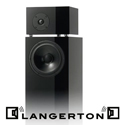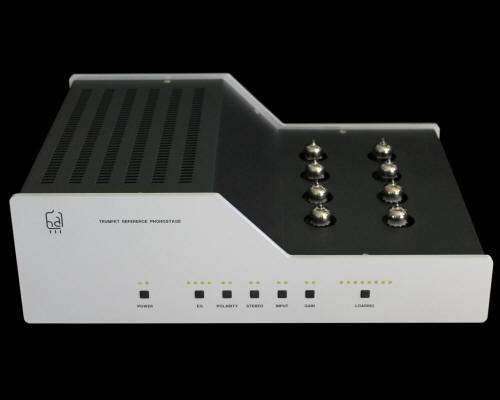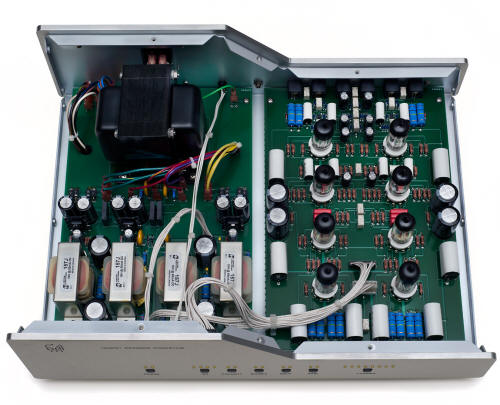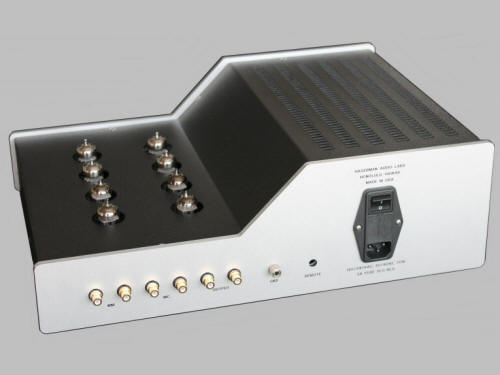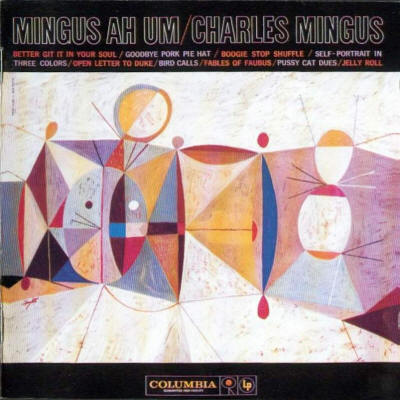|
|
You are reading the older HTML site
Positive Feedback ISSUE 78
hagerman audio labs Trumpet Reference Phonostage Preamplifier as reviewed by Mark Pearson
For more about Hagerman Audio labs, read an interview with Jim Hagerman HERE The Hagerman Audio Labs Trumpet Reference phono stage sits at the top of the mountain of the phono stages offered by Hagerman Audio Labs. I first laid eyes on the Trumpet Reference phono stage at RMAF 2014 where Jim Hagerman was displaying it in the same room where all of the LPs were being sold. I was impressed with the build quality of the Trumpet Reference as I examined it on Jim's table at RMAF. The power supply uses four chokes whereas some manufactures like to brag that they have one choke in their power supply. The power transformer is also big and beefy. The main circuit board carrying the audio signals which contains the eight vacuum tubes (four 12AX7s and four 12AU7s) floats inside the chassis in order to help with the reduction of microphonics. All of the circuit boards are high-quality boards and the workmanship on the boards is also very high quality as are the parts used (the coupling caps are all MIT).
The Hagerman Trumpet Reference uses a fully balanced circuit. Since there a fair number of people who are using balanced XLR connectors starting at their phono cables, I was surprised that Hagerman didn't offer XLR input and output connectors as an option for the Trumpet Reference since it is a truly balanced design. According to Jim Hagerman, you still obtain benefits of a balanced circuit in his implementation. The Hagerman Trumpet Reference comes with a wired remote control. Having talked to Jim at RMAF, the intent of the wired remote is to allow you to optimize the settings of your cartridge and once you have them dialed in, you unplug the wired remote from the back of the Trumpet Reference. Implementing a wired remote would have been easy enough, but it would have added an additional cost and Jim Hagerman decided against it because he thought it was one more unnecessary remote to have to contend with.
When using a MC cartridge, you have your choice of two gain settings (64db and 70dB) and you have eight choices for loading (57 ohms up to 1k ohms). With my Dynavector XV-1S cartridge, I settled for 91 ohms for loading and 70dB for gain and then unplugged the remote and never used it again. The Trumpet Reference also has a MM input with a fixed loading of 47k and gain fixed at 44dB. The Hagerman has 4 different equalization curves built in for those who like to experiment with equalization curves that were used when dinosaurs roamed the earth. I left the Trumpet Reference set to the RIAA curve and never looked back. The Trumpet Reference is one of those bullet-proof products that is easy to setup and operate and you expect it to operate perfectly every time. I love the feel of the sealed relay switches and how this phono section operates. After you have pressed the power button to the "on" position on the back panel (you only need to do this once), you press the power button on the front panel and the power supply turns on the heaters to the tubes and allows them to warm up for 32 seconds before it switches the B+ on to the plates of the tubes. There are two LEDs above the power switch on the front panel. When the power switch is pushed, the left LED above the power light comes on. After the heaters have warmed up for 32 seconds and B+ is applied to the tube plates, the second LED above the power switch turns on and you are ready to play music. So how does the Hagerman Trumpet Reference sound? In a word, marvelous. My reference phono section is the Krell KPE Reference and the two phono preamps couldn't sound anymore different. Yes, the KPE is quieter, but that is to be expected because it is pure solid state. However, that is the only benefit the KPE brings to the table (pun intended) compared to the Hagerman Trumpet Reference. Compared to the Trumpet Reference, the KPE sounds quiet, polite, and squeaky clean. In other words, it sounds like it has been scrubbed clean and more than some of the music has been scrubbed off the input signal in comparison to the Trumpet Reference. The Trumpet Reference captures the body and tone of instruments in a way that eludes my KPE. Every instrument simply sounds more three dimensional and thus real and that includes voices. When I say this, I don't just mean some instruments; I mean every instrument sounds better through the Trumpet Reference. If there is a genre of music that has more incredible drum work and solos that rival the sound of real drums being played or the sound captured on the famous (or infamous) direct to disc Sheffield Drum LP than jazz music, someone please let me know what it is. What the Hagerman portrays is how each drum is tuned so that when it's struck, you not only can hear the fundamental frequency the drum head is tuned to, but you hear the sound of the cavity of the drum and how that sound including all of the harmonics loads into the room so you hear the reverberant decay of the actual recording space. Cymbals are a joy to listen to as well whether they are struck by drumsticks or struck with brushes. The Trumpet Reference captures the sound of the metal being struck and the air in the room being cut through by the pressure waves emanating from the cymbals. One example of my disappointment when switching back to the KPE after having the Trumpet Reference in my system was listening to Neil Young's Live at the Cellar Door (Reprise 525854-1). This was a live concert at a small venue in D.C. that was recorded in 1970, a year before Live at Massey Hall. For many Neil Young fans, Live at Massey Hall is held in high regards in terms of both his performance and the sound quality of this live recording, especially among those who love LPs. As good as Live at Massey Hall is, Live at the Cellar Door is a whole new ball game. Looking at my listening notes from Live at the Cellar Door, in particular the song "See the Sky About to Rain," I jotted down that the Tempest Reference will do dynamics in spades if the source material will allow it. And if you don't hear great dynamics, it's certainly not the fault of the Tempest Reference. Neil Young's guitar, piano, and voice are recorded much better on Live at the Cellar Door than they are on Live at Massey Hall and the Trumpet Reference lets you clearly hear the difference in recordings. Switching back to my KPE and playing songs from Live at the Cellar Door was a big letdown. Gone were the thunderous dynamics. Ditto for the three dimensional portrayal of Neil's voice. I no longer felt like I was sitting in the front row as this concert was being performed. The Trumpet Reference seems to capture all of the harmonic information available in a given recording which helps bring recordings to life (which is something tubes excel at). Some components are good at grabbing the leading edge of fundamentals and running with them, but they sound threadbare by comparison because they are all bones and no meat. I know that some people are entranced by that sound because it sounds "fast" and "clean," but to me it's a sound devoid of crucial information and it quickly becomes boring once you realize what you are missing. Charles Mingus Tijuana Moods (RCA LSP-2533) is another mind-blowing recording from 1957. There must have been something magical about 1957 with regards to the recording gear that was used and the recording engineers who used said equipment. Obviously 1957 recordings were made using vacuum tubes and tape circa 1950s technology. Too bad present day recordings don't come close to the giant slice of reality that was laid down in 1957 across many recordings. The first cut on this LP is "Dizzy Moods." The bass, drums, cymbals and horns sound so alive it's almost scary. This is a seriously dynamic recording. The way the trumpet cuts through the air has to be heard to be appreciated. "Ysabel's Table Dance" is another real treat to hear. The castanets are in the room with you. This is a very live, dynamic recording with lots of high frequency information. Another great recording from 1957 is Art Pepper …the way it was! (MFSL 1-297). Again my listening notes indicate my unhappiness with the current sound of recordings being made vice what was being laid down in 1957. This recording was made in January 1957 and just as I have written previously with regards to the Sonny Rollins Way Out West LP from the same year, some people need to hang their heads in shame for recording music that doesn't come close to the sound quality being recorded in 1957. The second song on …the way it was! is "All The Things You Are." This is simply a gorgeous recording and the Trumpet Reference lets it all flow and gives you all the micro and macro dynamics encoded in the recording. The acoustic bass line is so tight as it plays over the drums.
Charles Mingus Mingus Ah Um (Columbia 88697335681-A) is another "go to" recording and the Trumpet Reference showed why. This recording is one more example of a 1950s LP that captures the sound of instruments so that they sound live. The cymbals sound like they are being struck right in front of you. The dynamics of this recording are off the chart and the Trumpet Reference just gets out of the way and doesn't sanitize any of the information present and scrub it away so maybe your senses won't be offended by all the dynamic range and the full tonal colors that exist in the recording. Coleman Hawkins LP Coleman Hawkins And His Confreres (QRP/Verve MG VS-6110) is yet another 1950s recording (1958) with great sound. The song "Honey Flower" has a nice walking bass line that is properly rendered by the Trumpet Reference. When the piano comes in it sounds properly scaled with regards to the other instruments (unlike The Three Blind Mice 45 RPM box set where the piano stands out like a giant zit on a contestant at a beauty pageant). In summary, if you want to hear what is encoded in your LPs and not some carefully engineered sanitized version that was crafted to create a "sound" that appears to be "fast" and "clean," you need to hear what the Trumpet Reference can do if you are shopping in this price range. The Trumpet Reference brings recordings to life and you can easily separate out the good, the bad, and the ugly when it comes to the recordings you own. The Trumpet Reference will not run them through a giant filter such that all recordings are homogenized and sound the same. There is nothing boring about the Trumpet Reference unless you are playing a boring recording through it. And one more thing: Jim Hagerman mentions in his owner's manual that he recommends "tube rolling" with the Hagerman Trumpet. There were zillions of 12AX7s and 12AU7s made during the golden years of tube manufacturing as these were common tubes. As some of you know by now, I do not roll in tubes for a review. I simply believe that I should review a piece of tube gear the same way you are going to receive it and hear it. After all, if a manufacturer can't design, build, and bring a great sounding piece of tube audio gear to market using current production tubes, something is wrong. There is something very ‘right' about the Hagerman Trumpet Reference and I hope that those who are interested in a top level tube phono section will have an opportunity to hear Jim Hagerman's best work to date. Mark Pearson For more about Hagerman Audio labs, read an interview with Jim Hagerman HERE
Hagerman Trumpet Reference phonostage
Hagerman Audio Labs |










